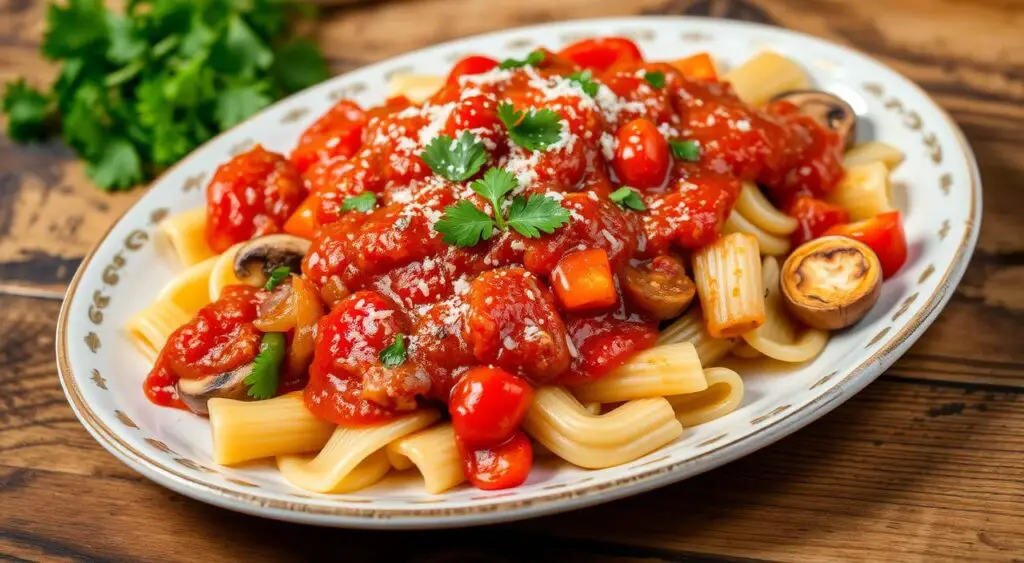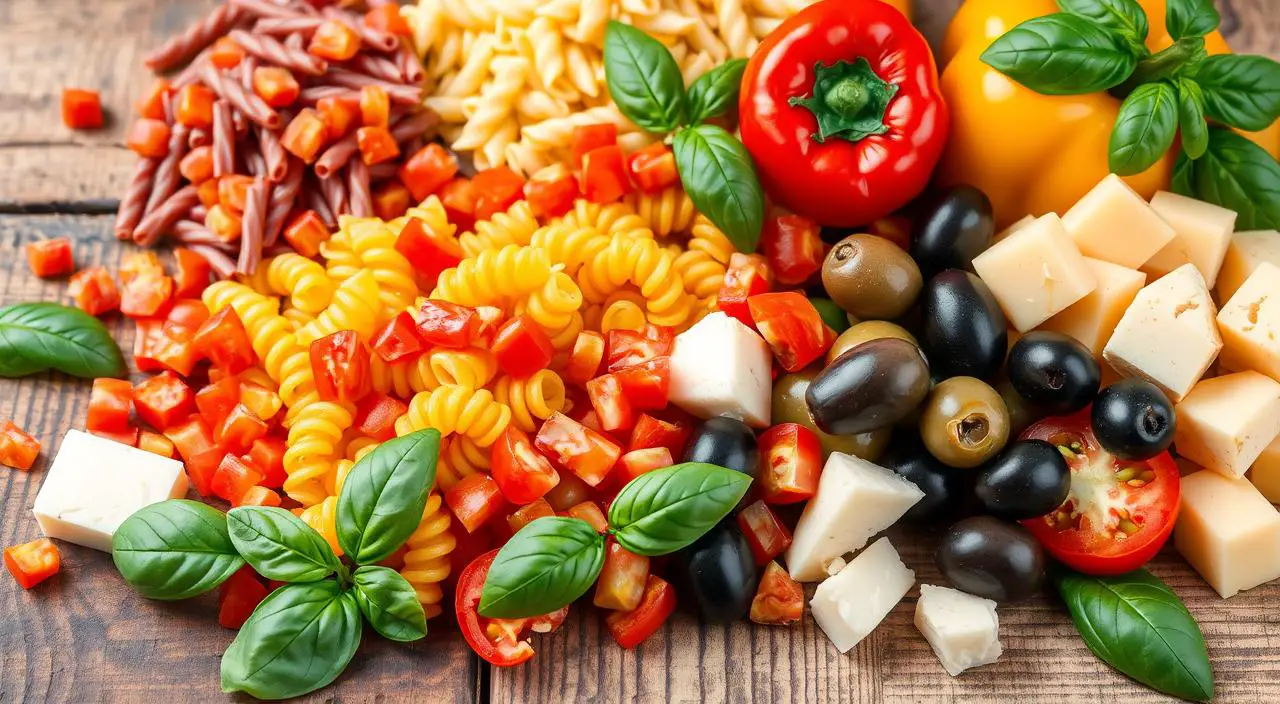Ever curious about the tasty pasta dish called cavatini? It’s a mix of Italian and American flavors, loved by many in the U.S. But what are the main ingredients that make cavatini so special?
In this guide, we’ll look into cavatini’s history and what it’s made of. We’ll cover the pasta types, the meat and sauce, and more. So, let’s find out what makes cavatini a favorite comfort food!
Key Takeaways
- Cavatini is a popular Italian-American pasta casserole dish
- It features a combination of various pasta shapes, ground meat, cheese, and tomato-based sauce
- The dish’s origins and recipe have evolved over the decades, with regional variations
- Cavatini is versatile, allowing for the inclusion of different protein sources and vegetable add-ins
- Proper preparation and layering techniques are essential for achieving the perfect cavatini
Understanding the Origins and History of Cavatini
Cavatini is a favorite Italian-American pasta dish with a rich history. It combines Italy’s culinary traditions with the unique tastes of the United States. This Italian-American fusion dish came from Italian immigrants who brought their food heritage to America.
Italian-American Fusion Origins
In the early 1900s, Italian immigrants wanted to make dishes that reminded them of home. But they had to use ingredients they found in America. This mix of Italian cooking with American ingredients led to the creation of cavatini and other pasta dishes.
Evolution of the Recipe Through Decades
Over the years, cavatini became a favorite in Italian-American homes. People and restaurants started adding their own twists to the recipe. This led to the many cavatini recipes we see today.
Regional Variations and Adaptations
Cavatini has different versions across the United States. Some have a strong tomato sauce, while others use ground beef and Italian sausage. The choice of pasta shapes and added vegetables also changes by region. This shows how different cultures have influenced this pasta dish.
“Cavatini is a testament to the enduring legacy of Italian-American cuisine, where the rich flavors of the old world seamlessly blend with the vibrant tastes of the new.”
Essential Pasta Types Used in Traditional Cavatini
The choice of pasta shapes is key in cavatini. It affects the texture and flavor. Traditional recipes use different pasta types for unique qualities.
Rotini is a common choice. Its corkscrew shape traps sauce, making each bite flavorful. Penne is also popular. Its tubular shape and ridges hold onto sauce well.
Shells add a heartier bite. Their large, concave shape scoops up sauce. This shape contrasts with other ingredients, enhancing texture.
Together, these pasta shapes create a balanced cavatini. The mix of rotini, penne, and shells offers a delightful mouthfeel. It makes diners want more.
| Pasta Shape | Contribution to Cavatini |
|---|---|
| Rotini | Excellent at trapping and holding onto the sauce |
| Penne | Tubular shape and ridged surface help the sauce cling to the pasta |
| Shells | Large, concave shape is perfect for scooping up the rich, saucy goodness |
Using cavatini pasta shapes like rotini, penne, and shells balances the dish. It complements other ingredients perfectly.
The Classic Meat Components and Protein Options
Cavatini is known for its mix of ground beef and Italian sausage. These ingredients blend perfectly, creating a bold, savory flavor. But, new protein options are also changing the game, adding unique twists to this classic pasta casserole.
Ground Beef and Italian Sausage Combinations
The mix of ground beef and Italian sausage is a cavatini staple. Ground beef gives it a meaty base, while Italian sausage adds spice and a hint of fennel. This combo creates a perfect balance of texture and taste, making cavatini so comforting.
Alternative Protein Choices
- Ground turkey or chicken: These leaner options offer a healthier take on cavatini, keeping it tasty and satisfying.
- Plant-based “meat” crumbles: For a veggie or vegan option, soy-based or other plant-based meats can be a tasty, protein-rich choice.
- Lentils or beans: Legumes like lentils or beans add protein and a special texture, making them a great plant-based option.
Proper Meat Seasoning Techniques
Seasoning is key to a great cavatini filling, no matter the protein. Use Italian herbs, garlic, onions, and a bit of red wine or tomato paste. This mix enhances the meat’s flavor, blending well with other ingredients. Proper seasoning makes every bite of cavatini rich and savory.
What is Cavatini Made Of? Breaking Down the Core Ingredients
To understand cavatini, we need to look at its main parts. This dish is a mix of several key ingredients. Each one is important for its taste and texture. Let’s dive into the cavatini ingredients list and see what makes this dish so loved.
The Pasta Foundation
The pasta is the base of cavatini. Recipes often use cavatappi or elbow macaroni. These shapes help the other ingredients blend well, making a tasty casserole.
The Protein Powerhouse
Cavatini gets a boost from ground beef and Italian sausage. These add flavor and make the dish hearty, perfect for a meal.
The Cheese Factor
Cheese is essential in cavatini. Mozzarella, cheddar, or a mix is used for a gooey, creamy top. It holds the dish together.
The Sauce Harmony
The sauce is what keeps cavatini together. It’s made from tomato sauce, diced tomatoes, and spices like oregano and garlic. This sauce coats the pasta and adds flavor.
Vegetable Additions
Vegetables like onions, bell peppers, and mushrooms add freshness. They also bring more flavor and nutrients to the dish.
Knowing what makes cavatini special helps us appreciate its flavors and textures. Whether you’re new to cavatini or experienced, understanding its ingredients will help you make a delicious dish.
| Cavatini Ingredients List | Description |
|---|---|
| Pasta | Cavatappi or elbow macaroni |
| Protein | Ground beef and Italian sausage |
| Cheese | Mozzarella, cheddar, or a blend |
| Sauce | Tomato-based with herbs and spices |
| Vegetables | Onions, bell peppers, mushrooms |
“Cavatini is a classic pasta casserole that brings together a harmonious blend of flavors and textures, creating a comforting and satisfying dish that’s perfect for any occasion.”
Signature Sauce Elements and Preparation
At the heart of a delectable cavatini dish lies its signature tomato-based sauce. This flavorful sauce serves as the foundation, infusing each bite with a delightful blend of Italian herbs and spices. Let’s explore the key components that make this sauce truly remarkable.
Tomato-Based Sauce Foundation
The cavatini sauce recipe starts with a rich, tomato-based foundation. We carefully select the finest quality canned crushed tomatoes or tomato puree to create a vibrant, tangy base. The natural sweetness and acidity of the tomatoes provide the perfect canvas for the subsequent flavor additions.
Herbs and Spices Mix
- Fragrant Italian herbs, such as oregano, basil, and rosemary, are essential for infusing the sauce with an authentic Mediterranean aroma.
- A blend of aromatic spices, including garlic, onion powder, and a touch of crushed red pepper flakes, adds depth and complexity to the overall flavor profile.
- The careful selection and balance of these Italian herbs and spices elevate the cavatini sauce, making it a true taste of Italy.
Sauce Simmering Methods
To achieve the perfect consistency and depth of flavor, we recommend simmering the cavatini sauce for an extended period. This slow-cooking process allows the flavors to meld and the sauce to thicken, resulting in a rich, velvety texture that clings beautifully to the pasta.
By following these signature sauce elements and preparation techniques, we ensure that each cavatini dish is a harmonious blend of tantalizing tomato, fragrant herbs, and spices, delivering a truly satisfying and delicious dining experience.

Cheese Varieties and Layering Techniques
Creating the perfect cavatini is all about the cheese. Mozzarella and parmesan are key, each adding its own flavor and texture. Let’s dive into the cheese world and learn how to layer them for the best taste.
Mozzarella: The Quintessential Cavatini Cheese
Mozzarella is essential for cavatini. Its creamy texture melts well, blending with pasta, meat, and sauce. Fresh mozzarella is best for its great melting and taste.
Parmesan: The Flavor Enhancer
Parmesan adds a rich flavor to cavatini. Its sharp, nutty taste complements the other ingredients, creating a delicious balance.
To layer cheese well, start with mozzarella at the bottom. Then, add parmesan, alternating between the two. This way, every bite is cheesy and perfect.
| Cheese Type | Role in Cavatini | Recommended Quantity |
|---|---|---|
| Mozzarella | Provides the quintessential creamy, melty texture | 1-2 cups, depending on dish size |
| Parmesan | Adds a depth of flavor with its sharp, nutty notes | 1/2 – 1 cup, to taste |
With the right cheese and layering, your cavatini will be amazing. Get ready for a dish that’s bubbly, golden, and full of flavor.
Fresh Vegetables and Add-ins for Enhanced Flavor
In the world of cavatini, fresh vegetables are key to boosting flavor. They add taste and nutrition to this Italian-American dish.
Essential Vegetable Components
The base of a tasty cavatini is a mix of bell peppers, onions, and mushrooms. These ingredients blend to make a savory dish.
- Bell peppers add a sweet and crunchy touch, enhancing flavors.
- Onions bring depth to the dish, improving its aroma and taste.
- Mushrooms add an earthy flavor, tying the dish together.
Optional Vegetable Additions
While the main trio is crucial, other veggies can also enrich cavatini. Some great options include:
- Diced tomatoes for a fresh and tangy taste
- Spinach or kale for extra nutrients
- Zucchini or eggplant for a hint of sweetness
- Olives for a salty, savory flavor
Choosing and mixing these veggies can make your cavatini look great and taste amazing.
| Vegetable | Contribution to Cavatini | Nutritional Benefits |
|---|---|---|
| Bell Peppers | Adds sweetness and crunch | Rich in vitamins C and A, and antioxidants |
| Onions | Provides depth of flavor and aroma | Contains sulfur compounds with anti-inflammatory properties |
| Mushrooms | Lends an earthy, umami-rich note | High in B vitamins and selenium, with antioxidant effects |
Adding these cavatini vegetables makes your dish not just tasty but also nutritious. Try different mixes to find your favorite flavors and textures.
Step-by-Step Assembly Process
Making a delicious cavatini casserole is a fun cooking adventure. It doesn’t matter if you’re an experienced cook or just starting out. Our guide will help you layer and bake your cavatini perfectly every time.
First, heat your oven to 375°F (190°C). Get all your ingredients ready. This includes cooked pasta, seasoned ground beef or Italian sausage, tomato sauce, and cheese.
- Start by spreading a thin layer of tomato sauce at the bottom of a 9×13 inch baking dish. This prevents sticking.
- Then, place a layer of cooked pasta on top. Overlap the pieces a bit for an even base.
- Put a generous amount of seasoned meat on top of the pasta. Spread it out evenly.
- Next, add a lot of tomato sauce over the meat. Make sure it covers the whole surface.
- Now, sprinkle shredded mozzarella and grated Parmesan cheese over the sauce.
- Keep repeating the layers of pasta, meat, sauce, and cheese until you reach the top. Finish with cheese.
After you’ve built your cavatini, cover it with aluminum foil. Bake for 30 minutes. Then, remove the foil and bake for another 15-20 minutes. This will melt the cheese and make the edges golden.
Let the cavatini rest for 5-10 minutes before serving. This helps the layers set and makes it easier to serve. Enjoy your homemade cavatini casserole, a tasty mix of Italian-American flavors!
Storage Tips and Reheating Methods
Keeping your homemade cavatini fresh is easy with the right storage tips. Whether you’re storing leftovers or prepping ahead, we’ve got you covered. Our tips will help keep your cavatini tasty and fresh.
Proper Storage Containers
Use airtight, leak-proof containers to store cavatini. Choose sturdy glass or high-quality plastic. Thin, flimsy bags or containers won’t keep air and moisture out.
Freezing and Thawing Guidelines
Freezing is great for long-term storage. Portion the dish into servings or family sizes and freeze. Let it thaw in the fridge overnight before reheating.
To reheat, use the oven or stovetop. For the oven, preheat to 350°F (175°C) and bake covered for 30-40 minutes. On the stovetop, heat in a saucepan over medium, stirring often.
| Storage Method | Recommended Containers | Shelf Life |
|---|---|---|
| Refrigerator | Airtight glass or plastic containers | 3-4 days |
| Freezer | Freezer-safe containers or bags | 2-3 months |
Follow these tips for storing and reheating cavatini. Enjoy your delicious dish for days or weeks. Bon appétit!
Conclusion
We’ve looked into the cavatini dish and found its rich history and ingredients. This Italian-American casserole has become a favorite in many homes in the U.S. over the years.
The dish combines pasta, meat, sauce, and cheese in a way that’s both satisfying and comforting. Adding fresh veggies boosts its nutritional value and taste.
Making your own cavatini is easy and rewarding. It’s great for family dinners or special events. With the right storage and reheating, you can enjoy it many times, making it perfect for busy days or celebrations.

